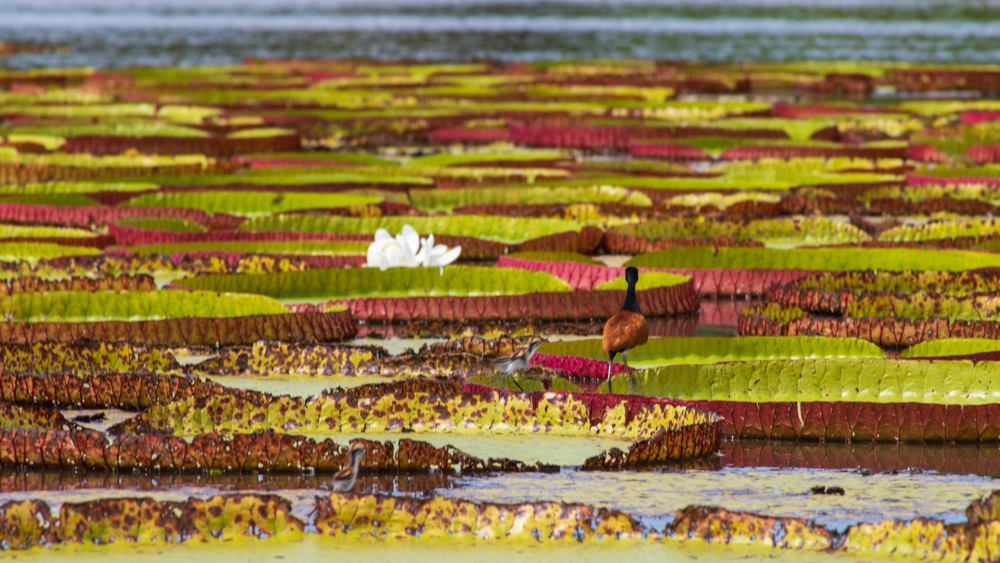A nature lover’s paradise, home of myths, legends and giants
MELANIE McTurk is the Managing Director of Karanambu Lodge, located in North Rupununi—a family-owned oasis on the banks of the Rupununi River, set deep within the vast natural lands.
Karanambu Lodge is famous as the pioneer of eco-tourism and conservation in Guyana. It is a collection of thatched-roof cabins at the heart of 115 square miles of private protected area.

Karanambu Lodge is a small family business that, in partnership with The Karanambu Trust, is committed to the conservation of the Karanambu area, providing maximum benefits to local communities through inclusive conservation, and creating opportunities for community participation in the tourism value chain.
Established in 1997 by Diane McTurk, the Karanambu Trust saw the creation of Karanambu as Guyana’s first Private Protected Area. Today, Karanambu serves as a crucial sanctuary for numerous species and a key hub for conservation efforts.

Karanambu provides high-quality eco-tourism experiences to both domestic and international travellers and is committed to ensuring that we do so through an environment that demonstrates respect for ourselves and staff, guests, local communities, the natural environment, and local history and culture.
For almost 100 years, Karanambu Lodge has welcomed explorers and researchers. Guests are invited to share meals around the family dining table and chat over a cold glass of rum punch, in the original home of eco-tourism and local conservation.

The Karanambu Lodge is at the heart of approximately 110 square miles of savannah, marshy ponds, riparian forest, and a 30-mile stretch of the Rupununi.
According to McTurk, Karanambu Lodge is one of the oldest nature-based tourism destinations—a true conservation area in Rupununi, a remote place which became the Karanambu Trust.
She told Pepperpot Magazine that the lodge was established by the McTurks in the 1920s by one Edward McTurk, better known as Tiny, who was recognised for his balata collection—a hobby he developed and enjoyed over time, in which he created a balata station to display his original pieces.
McTurk added that he founded the ranch to earn money for himself, his family, and his employees. As an amateur naturalist, he was very fond of the environment, and he often studied the plants, animals and other things in nature.
McTurk’s husband is a descendant of Edward McTurk, and it is one of the places in Guyana often visited by renowned scientists, filmmakers, and tourists alike to get their fill of nature at its fullest.
McTurk stated that in the 1980s, when the tourism industry began offering nature tours, Karanambu Lodge tapped into it and became recognised and registered with the relevant authorities.

“Back then, when visitors came, they went to the lodge because Edward McTurk was the man to talk to—he was a wealth of knowledge as a naturalist and conservationist who was self-taught,” she said.
The Karanambu area is approximately 115 square miles of savannah, ponds, forests, and a 20-mile stretch of the Rupununi River situated in the heart of the Rupununi Wetlands.
It is part of a watershed where the Amazon and Guiana Shield river systems meet. Karanambu is a biodiversity hotspot with more than 700 aquatic species, over 400 species of birds, four species of caiman, five species of monkeys, foxes, jaguar, tapir, capybara, excellent viewing opportunities for giant otters, giant anteaters, and one of the world’s best wild collections of Victoria Amazonica water lilies.
McTurk pointed out that Karanambu Lodge has five habitats and is the ideal area to see giant otters, giant anteaters, birds, and plants.
She stated that they also do animal rescue, but they do not keep animals for entertainment purposes. They are free-range, and it is the oldest privately protected area in Guyana.
McTurk related that Diane McTurk, who has since passed away, was one of the pioneers who saved the species of otters from becoming extinct in the river system and was recognised for her efforts.
She explained that there is a peak season for visitors at the lodge and, as the Managing Director, during off-peak season, it gives them time to focus on conservation projects and help communities such as Rewa, Caiman House, Toka and others.
“We empower others to become a part of the tourism chain—protecting the ecosystem/wildlife as a sustainable way of earning for the community, which includes Yupukari, Massara and Kamwatta,” she said.
McTurk noted that the peak season for Karanambu Lodge is in September, and from December to April, they take a break. She enjoys the opportunity to share with others about the truly unique protected area, which has so much to offer.
She added that they incorporate local menus for meals, they have adequate accommodation with both a rustic and modern touch, and they have a series of activities for visitors, such as nature spotting, fishing, and bird watching, among others.
McTurk told Pepperpot Magazine that Karanambu Lodge is remote. To get there, one can take a bus or a plane to Lethem, then it takes two and a half hours to reach the location by vehicle—but it is unlike any other place.
She related that the best part about living there is falling asleep under the thatched roof cabin, listening to the rainfall, and waking up to the chirping of the birds.
McTurk revealed that the McTurks have been in Guyana for five generations, and they are looking forward to their 100th year celebration in 2027.
Karanambu Lodge and Protected Area has six species of monkeys, more than 700 species of fish, nine giant species, five habitats, 115 square miles of land, 35 ponds, 20 miles of river, 400 bird species, and is home to the national flower of Guyana—the Victoria Amazonica.





.jpg)








